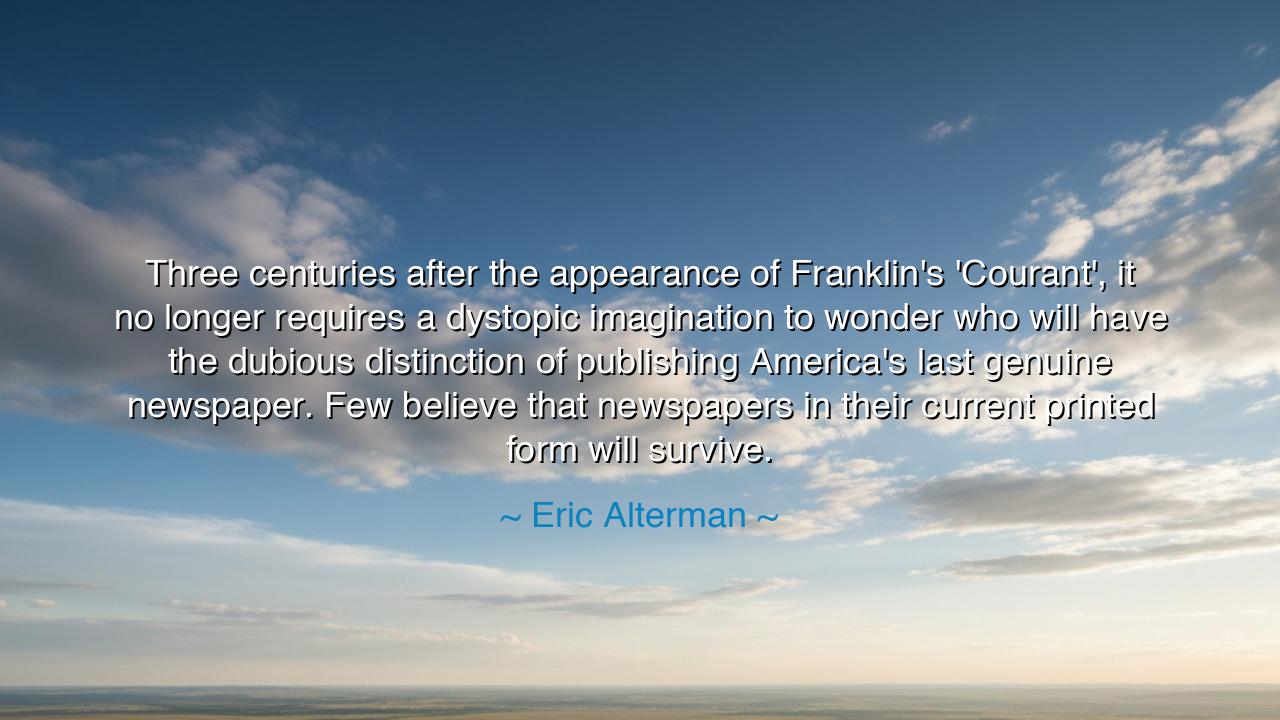
Three centuries after the appearance of Franklin's 'Courant', it
Three centuries after the appearance of Franklin's 'Courant', it no longer requires a dystopic imagination to wonder who will have the dubious distinction of publishing America's last genuine newspaper. Few believe that newspapers in their current printed form will survive.






"Three centuries after the appearance of Franklin's 'Courant', it no longer requires a dystopic imagination to wonder who will have the dubious distinction of publishing America's last genuine newspaper. Few believe that newspapers in their current printed form will survive." These words from Eric Alterman bring forth a powerful and poignant reflection on the evolution of the media, and more specifically, the newspaper, which has long been a cornerstone of public discourse and democratic dialogue. The reference to Franklin’s ‘Courant’, one of the first publications to provide a platform for public debate in colonial America, reminds us of a time when newspapers were the soul of communication, when the written word carried the weight of truth and civic duty. Yet, in Alterman’s words, there is a warning—the newspaper, in its printed form, now stands on the precipice of extinction.
In the ancient world, the written word held a sacred place, and those who could record and share knowledge were revered. Consider the ancient Greeks, where the works of Homer, Herodotus, and Plato were transcribed and passed down through generations. The word was the means by which knowledge was preserved, societies were informed, and cultures were shaped. The scrolls and tablets upon which these works were written were not mere objects; they were the vessels of human thought, carrying the essence of ideas, philosophies, and truths. The newspaper of today is no different—it is the modern scroll—the medium by which we understand the world, communicate with each other, and hold our societies accountable.
Yet, as Alterman suggests, the medium of the newspaper—like all things in the natural world—faces the inevitable cycle of decay and change. Just as the scrolls of ancient Greece and Rome eventually gave way to the codex and then the printing press, the printed newspaper now confronts the digital age, where information is no longer confined to pages but flows ceaselessly through the ether. The printing press, once heralded as a revolutionary force that democratized knowledge and information, now finds itself challenged by online media, where news is instantaneous, transient, and often fragmented.
In the same way that the ancient scrolls were gradually replaced by more efficient means of recording and distributing knowledge, the newspaper faces the daunting question of relevance in the digital era. The Telegraph, the first news service in ancient Rome, spread messages across the empire, and later the printing press was the engine of the Renaissance and Reformation. Yet, even the great innovations of their times were eventually replaced, giving way to the next technological leap. The question now is not whether the newspaper will disappear, but what will replace it, and more importantly, how will society continue to inform itself, debate, and engage with truth in a world where credibility and access are constantly challenged by the speed of the internet.
The decline of the printed newspaper—once the heartbeat of democratic societies—leaves us with a profound challenge: how do we ensure that the public discourse and the free exchange of ideas continue in an age of information overload and digital fragmentation? Consider the example of The New York Times, which, over the course of a century, became one of the world’s most trusted sources of news. Yet, even such an institution faces a difficult future, as the world shifts toward digital platforms, where news is consumed in bytes, and the depth of information is often replaced by the immediacy of headlines. The challenge for modern societies is not simply about preserving a medium, but about maintaining the very principles of journalism—truth, accountability, and engagement with the world around us.
From the ancient world to the modern age, the written word has always been a reflection of the human desire for communication and understanding. The disappearance of the printed newspaper is not just the end of a medium; it is a reflection of the changing nature of our society. As we face the transformation of communication in the 21st century, we must ask ourselves: What kind of future do we wish to build? How will we continue to engage with the stories that shape our world? News has always been more than just information—it is the mirror of our collective soul, the means by which we understand our shared humanity. As Alterman suggests, the future of the newspaper may not lie in its physical form, but in our ability to adapt and preserve the essence of its mission: to inform, to challenge, and to engage.
The lesson we draw from this reflection is one of adaptation and responsibility. Just as societies have adapted to the changing means of communication over millennia, so too must we. The newspaper, in its printed form, may be waning, but the need for truth, for critical thinking, and for public dialogue remains. Let us embrace the digital age, but let us also remember the core values that made the newspaper so essential: a commitment to truth, to fairness, and to the betterment of society. The media landscape may change, but the power of the word, and its ability to shape the world, will endure as long as there are those who seek to speak, to hear, and to understand. In this, the soul of humanity will never falter.






AAdministratorAdministrator
Welcome, honored guests. Please leave a comment, we will respond soon